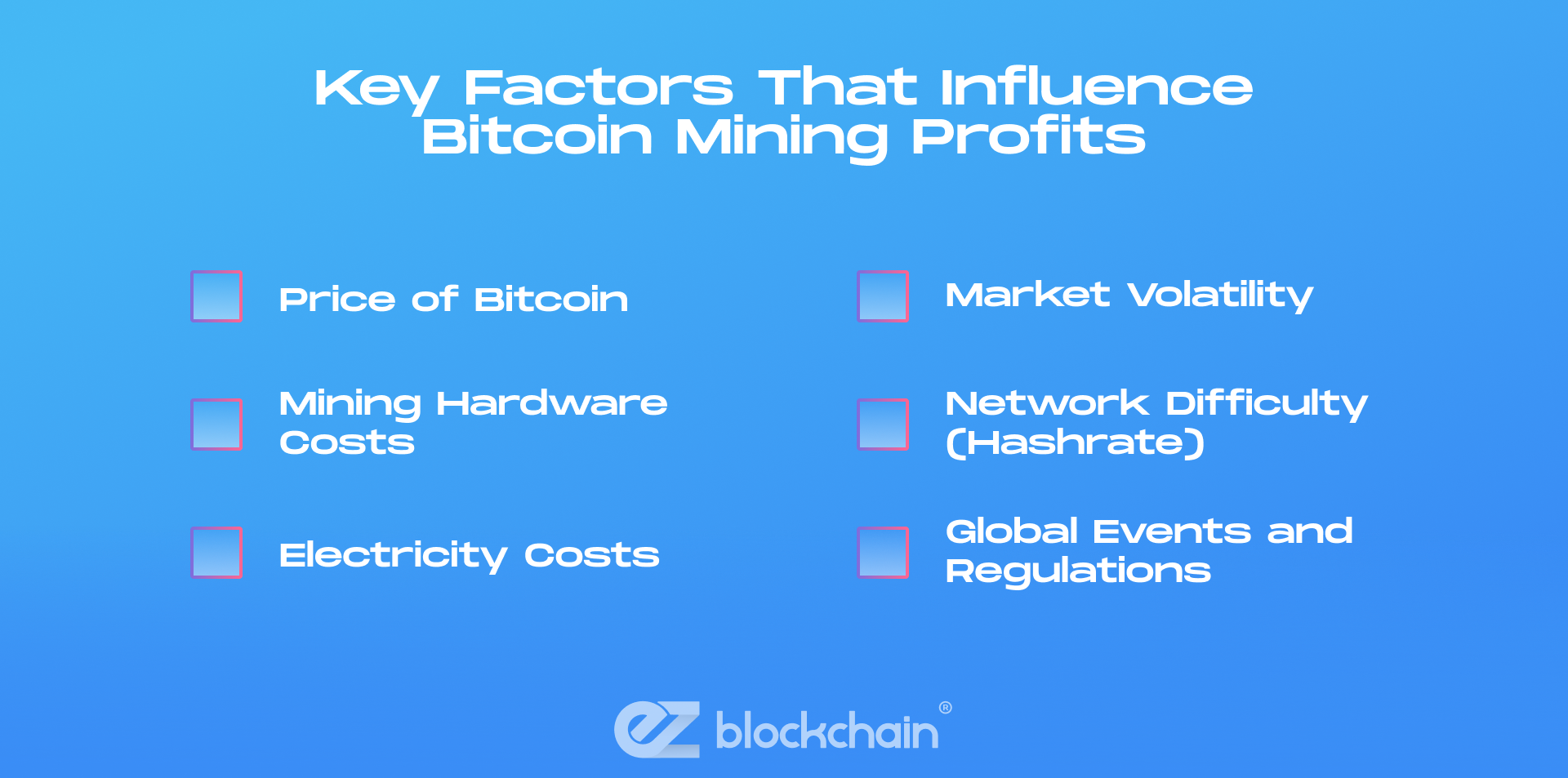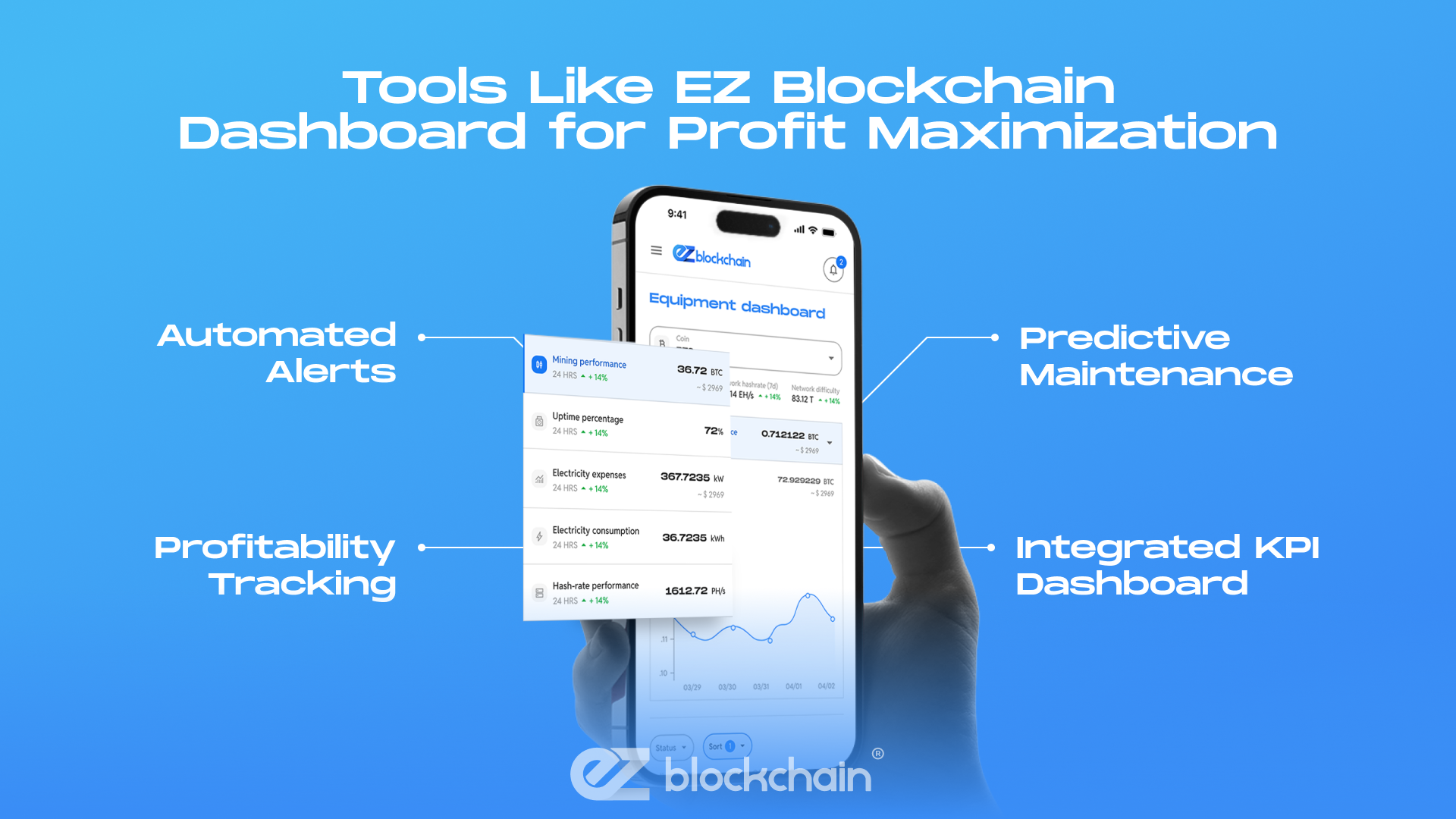Stay up to date with the latest news, announcements, and articles.
We’ll look at some of the best strategies in this post for taking higher profits from Bitcoin mining during bull markets and reinvesting them to keep your portfolio expanding. Readers will understand how it affects the profitability of Bitcoin mining. Whether you are thinking about mining alone or improving an industrial setup, this guide is meant to provide you the information you need to make wise choices in the ever-evolving Bitcoin mining industry.
Key Factors That Influence Bitcoin Mining Profits
Bitcoin mining operations tend to maximize profits by carefully controlling factors including the cost of mining hardware, network complexity, electricity costs, and the price of bitcoin. The price fluctuates a lot and has a big influence on how profitable mining is. Bitcoin mining profits will be higher when the price is high, but miners may not be able to make a living from mining when the price is low.
Miners must weigh the costs of mining, such as equipment purchases, electricity bills, and other overheads, in order to assess if mining Bitcoin is viable. The current block reward, transaction fees, and the probability of successfully mining a block must all be taken into account when estimating the possible mining payouts. Miners can use online calculators to predict their profitability based on these variables.

The Role of Hash Rate, Difficulty, and Block Rewards
The processing capacity of mining hardware is indicated by the hash rate, which is expressed in hashes per second (H/s). In general, a greater hash rate makes the network more secure and stable. However, when more miners join in, the hash rate rises, making mining more challenging.
Every 2016 blocks, the mining difficulty is automatically changed to maintain a constant block duration of roughly ten minutes. Miners require greater processing power when the difficulty increases. The quantity of mining Bitcoin profits given to miners is known as the block reward. In what is known as “the halving,” it is cut in half about every four years.
Choosing the Right Mining Hardware
Starting a mining enterprise requires a significant initial investment. Mining hardware can range in price from a few hundred dollars to several thousand dollars. The noise produced by the mining rigs and the amount of room required for equipment storage are further considerations for miners.
To get higher Bitcoin mining machine profit, especially ASIC miners, the typical decibel level is close to 90. According to research, noise levels over 70 dB can be hazardous, disrupt conversations, and reduce workplace efficiency. To lessen the effects of heat, operators should generally use a well-ventilated area or other soundproofing techniques.
ASIC Miners vs. GPUs: Which Is Best for You?
Bitcoin mining uses specialized technology called ASICs (Application-Specific Integrated Circuits) to solve intricate mathematical problems. The first miner to successfully solve these issues adds a new block to the blockchain and is rewarded with Bitcoin.
Studying ASIC Bitcoin mining’s history is crucial to appreciating its current status. Bitcoin mining has advanced significantly since its launch in 2009:
- 2009-2010: CPU Mining Era
- Standard computer processors might have been used for mining in the early days. A normal laptop might mine several bitcoins every day.
- 2010-2013: GPU Mining Revolution
- Graphics cards proved to be far more effective at mining, miners found. The first mining arms race resulted from this.
- 2013-Present: ASIC Domination
- With their previously unheard-of efficiency and hash rates, ASICs created specifically for mining took control.
The current environment, where specialized hardware and smart techniques are required for lucrative Bitcoin mining profit, is the result of this dynamic shift from GPU to ASIC.

Top ASIC Models for Optimal Mining Efficiency
Many security factors influence how much money you should budget for your mining setup. Due to the impact of the Bitcoin halving, the most recent ASIC variations may be bought for approximately $5,000, while the once-popular S19 model is currently priced at about $700. A modest GPU mining setup might also cost about $1,500. Find the best offers here.
| Model | Hashrate (TH/s) | Power Efficiency (J/TH) | Power Consumption (W) |
| Bitmain Antminer S19 Pro / XP | 104 – 140 | 29.5 – 21.5 | 3,075 – 3,010 |
| MicroBT Whatsminer M30S++ / M50 | 112 – 126 | 31 – 21 | 3,472 – 3,276 |
| Canaan AvalonMiner A1246 / A1346 | 90 – 110 | 38 – 30 | ~3,420 |
Optimizing Mining Efficiency
‘Whatever the industry, CE is driven by three main goals: Keep materials and products in use, optimizing their use over time through improved design and remanufacturing; Determine opportunities for reuse, recycling, and recovery; and Design waste and pollution out of the economic system by thoroughly costing impacts.’ — Circular Economy Leaders.
To calculate bitcoin mining profit in what was previously disposed of and allow for reclamation or re-insertion of materials back into the production cycle, put in place systems that monitor resource flows, including waste, by-products, and tailings. To bridge energy and material costs over the complete life cycle, leverage traceability, data, and the Bitcoin mining profit calculator to make decisions that prioritize recycling or reuse over disposal.
Minimizing Costs: Electricity and Maintenance
Improve the cooling system. It’s crucial to keep your hardware cool, but it doesn’t have to break the bank. Think about utilizing effective cooling options such as:
Immersion Cooling: Energy consumption can be greatly decreased and heat dissipation greatly enhanced by immersing your miners in a specialized liquid cooler.
Air Cooling with Strategic Ventilation: Using fans and exhaust systems to properly ventilate your mining area will assist in eliminating hot air and enhancing airflow.
Renewable Energy Sources: Examine the potential for powering your mining business using renewable energy sources, such as solar panels. This can minimize your electricity expenditures and greatly lessen your dependency on the grid.
To maximize ASIC work, EZ Blockchain incorporates cutting-edge renewable energy and maintenance technologies. We use mobile mining units fueled by flared or stranded gas and renewable integrations like solar arrays to offset electricity costs. This gives operators affordable energy paths that maximize mining uptime and reduce volatility levels.
Using Monitoring Tools to Track Performance
Mining operations that are successful depend on precise performance data and Bitcoin mining calculator profit. These monitoring tools give operators insight into hashrate stability (e.g., whether an Antminer S19 is reliably delivering 110 TH/s), energy consumption (real-time watts per terahash), temperature fluctuations (e.g., identifying hotspots above 75°C in GPU or ASIC units), and hardware health (noting malfunctioning fans or failing power supplies). An organized monitoring strategy also guarantees that mining resources are functioning within ideal bounds, prolonging the life of machinery and reducing unplanned breakdowns.

Tools Like EZ Blockchain Dashboard for Profit Maximization
The EZ Blockchain Dashboard provides operators with a comprehensive picture of mining operations by combining essential performance metrics on Bitcoin mining machine profit per day into a single platform. The purpose of this tool is to monitor productivity and improve financial success. View the main:
| Feature | Description | Use Case | Benefit |
| Automated Alerts | Sends notifications when performance metrics exceed thresholds | Alert if an Antminer’s hashrate drops below 105 TH/s | Immediate issue detection, reduces downtime |
| Profitability Tracking | Calculates real-time profit based on hashrate, energy costs, and Bitcoin price | Compare daily profit across multiple mining units | Helps optimize operations for maximum ROI |
| Predictive Maintenance | Uses performance trends to predict component failures | Forecast fan or power supply failure before it occurs | Minimizes unexpected hardware downtime |
| Integrated KPI Dashboard | Consolidates hashrate, energy efficiency, and operational costs in one platform | View ASIC fleet efficiency at a glance | Supports data-driven adjustments to maximize returns |
Mining Hosting
EZ Blockchain provides reliable mining hosting services, up-to-date ASIC miners, and experience-supported advice. We offer solutions that are specifically designed to match your needs, whether you’re just getting started or want to upgrade your Bitcoin mining machine profit per month. Our staff is here to assist you in streamlining your business processes and optimizing your revenue potential. For a free consultation and to learn how we can help you make your Bitcoin dreams a profitable reality, get in touch with us today.
Fill out a form and our bitcoin mining expert will contact you.
FREE CONSULTATIONchoose
a miner
profit and
understand data?
business remotely
with EZ Blockchain?
Fill out a form and our bitcoin mining expert will contact you.









